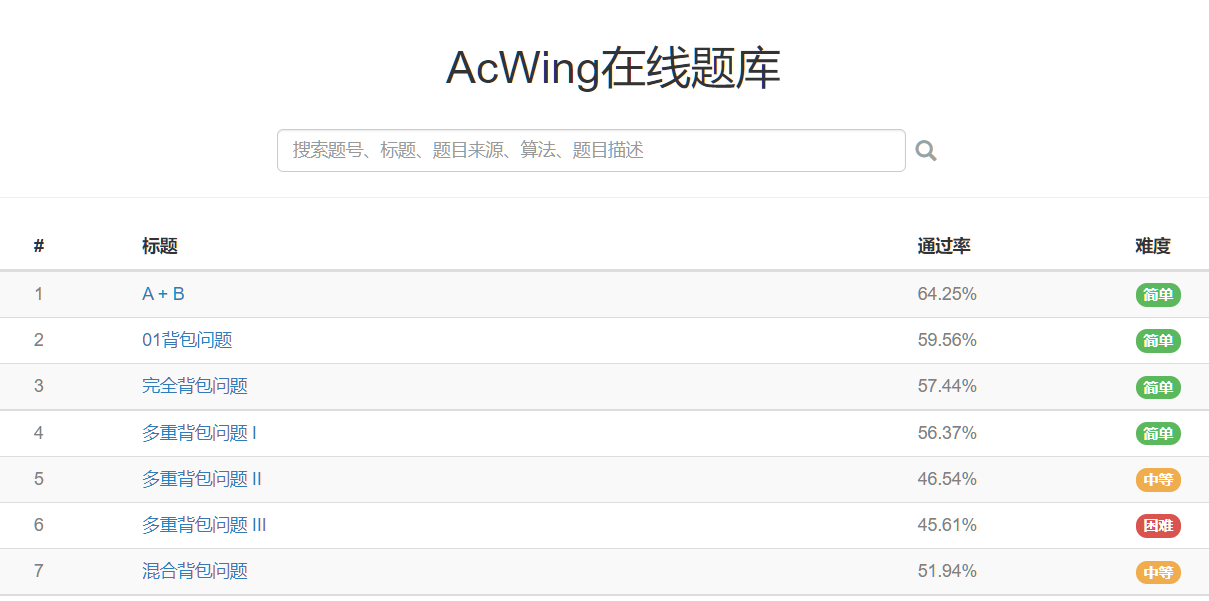写在前面 由于本课程是第一次面向本科专业开设,我身为第一届应考生,承担的考试压力要大许多。一是因为没有历年的真题供参考,另一方面是自己也并没有把太多心思放在这门课程的学习上。好在老师给出了复习提纲和样卷。那么我们就按照复习提纲和样卷来做一个全面的复习。
2021考题预测 1.插入算法
2.Master定理
3.DFS/BFS
4.回溯方法解决子集树/排列树的搜索问题
5.分支界限方法解决旅行商问题(较难暂时放弃)
6.Las解决0/1背包问题
7.动态规划方法解决多段图问题
8.贪心算法求解装载问题
9.归并排序/快速排序/二分排序
10.回溯方法解决最大团问题/子集和问题
2021期末预测题目全解 必须背下来的算法:
DFS 1 2 3 4 5 6 7 8 9 10 11 12 void DFS (Matrix<bool > &G,int v,vector <bool > visited,Func Visit) int n = G.Rows();1 ;for (int w =0 ;w<n;++w){if (not Visited[w] and G(v,w)){
BFS 1 2 3 4 5 6 7 8 9 10 11 12 13 14 15 16 17 18 19 20 void BFS (Matrix <bool > &G,int v,vector <bool > Visited,Func Visit) int n = G.Rows();queue <int > Q;1 ;while (not empty(Q)){for (int w=0 ;w<n;++w){if (not Visited[w] and G(v,w)==1 ){1 ;
回溯方法解决子集树搜索问题 1 2 3 4 5 6 7 8 9 10 11 12 13 14 15 16 17 18 #include <dummy.h> void B_SubSet (int n) vector <int > X (n) void (int )> SubSet = [&](int ){if (t>=n)else {if (legal(t)){1 ;1 );if (bound(t)){0 ;1 );
回溯方法解决排列数搜索问题 1 2 3 4 5 6 7 8 9 10 11 12 13 14 15 16 17 #include <dummy.h> void B_Perm (int n) vector <int > X(n);void (int )>Perm=[&](int t){if (t>=n-1 )cout <<X<<endl ;else {for (int i =t;i<n;++i){if (legal(t) and bound(t))1 );
Las解决0/1背包问题 1 2 3 4 5 6 7 8 9 10 11 12 13 14 15 #include <LasVegas.h> bool Knap (vector <double > &V,vector <double > &W,double c,double t,vector <bool > &X) static mt19937g;int n = min(size(V),size(W));double fv = 0 ,fw = 0 ;for (int i =0 ;i<n;++i){2 ;if (fw>c)return false ;return fv>=t;
贪心算法求解装载问题 1 2 3 4 5 6 7 8 9 10 11 auto Load (vector <double > &W,double M) int n =size(W);vector <bool >X(n,0 );double rc = M;for (int i=0 ;i<n and W[i]<=rc;++i){1 ;return X;
回溯方法解决最大团问题 1 2 3 4 5 6 7 8 9 10 11 12 13 14 15 16 17 Clique(t,cn)if (t>=n and cn >fn){ else if (t<n){if (Connected(G,X,t))1 ;1 ,cn+1 );if (cn+n-t>fn){0 ;1 ,cn);
回溯方法解决子集和问题 1 2 3 4 5 6 7 8 9 10 11 12 13 14 15 16 17 SetSum(t,s,r){if (not Y.empty())return ; if (s==M)else if (t<n){if (s+W[t]<=M){ 1 ;1 ,s+W[t],r-W[t+1 ]);if (s+r-W[t]>=M){0 ;1 ,s,r-w[t+1 ]);
归并排序 1 2 3 4 5 6 7 8 9 10 11 12 13 14 15 16 17 18 19 20 21 22 23 24 25 26 27 28 29 30 31 32 33 34 35 #include <algorithm.h> template <class T >void Merge (T X[],int low,int m,int up) int i = low,j = m,k=0 ;for (;i<m and j<up;k++)if (X[i]<X[j])else for (;i<m;i++){for (;j<up;j++){void MergeSort (T X[],int low,int up) if (up-low<=1 )return ;int m =(low+up)/2 ;
快速排序 1 2 3 4 5 6 7 8 9 10 11 12 13 14 15 16 17 18 19 20 21 22 23 24 25 26 27 28 #include <algorithm.h> template <class T >int Partition (T X[], int low, int up) int key = up-1 ;int m = low;for (int i =low;i<up;i++){if (X[i]<X[key]){return m;void QuickSort (T X[],int low,int up) if (up-low<=1 )return ; int m =Partition(X,low,up);1 ,up);
二分搜索 1 2 3 4 5 6 7 8 9 10 11 12 13 14 15 16 17 18 19 #include <algorithm.h> template <class T1 ,class T2 >int search (T x[],int n,const T2 &v) int low = 0 ;int up = n;while (low < up){int m =(low+up)/2 ;if (X[v]<X[m]){if (X[v]>X[m])1 ;if (X[v]==X[m])return m;return -1 ;
插入算法 1 2 3 4 5 6 7 8 9 10 11 12 template <class T ,class T2 >int insert (T X[],int m,const T2 &V) int p;for (p = m-1 ;p>0 and X[p]>v;--p)if (X[p]==v)return m;for (int i=m-1 ;i>=p;--i){1 ]=X[i];1 ] = v;return m+1 ;
图的遍历 二叉树的遍历 二叉树的C++表示 1 2 3 4 5 6 7 #include <algorithm.h> template <class T >struct BtNode //二叉树结点{ 0 ,*right = 0 ;
二叉树的先根次序遍历 1 2 3 4 5 6 7 8 9 template <class T ,class Func >void PreOrder (BtNode<T> *x ,Func Visit) if (x==0 )return ;
中根遍历与后根遍历只是调换了顺序,故不再赘述。
二叉树的按层次遍历 1 2 3 4 5 6 7 8 9 10 11 12 13 14 15 16 17 18 19 20 21 22 23 24 25 template <class T ,class Func >void LevelOrder (BtNode<T> *x,Func Visit) queue <BtNode<T> *> Q;if (x!=0 ){while (not empty(Q)){auto left = x->left;auto right = x->right;if (left!=0 )if (right!=0 ){
一般树的遍历 树的C++表示 1 2 3 4 5 6 #include <algorithm.h> template <class T >struct TreeNode {0 ,next = 0 ;
树的先根遍历 1 2 3 4 5 6 7 8 9 10 template <class T ,class Func >void PreOrder (TreeNode<T> *x,Func Visit) if (x==0 )return ;for (x=x->first;x!=0 ;x=x->next){
树的中根遍历只是与先根遍历的顺序不同,不再赘述。
树的后根遍历 1 2 3 4 5 6 7 8 9 10 11 template <class T ,class Func >void PostOrder (TreeNode<T> *x,Func Visit) if (x==0 )return ;auto t = x->first;for (;t!=0 ;t=t->next){
树的按层次遍历 1 2 3 4 5 6 7 8 9 10 11 12 13 14 15 16 17 template <class T ,class Func >void LevelOrder (TreeNode<T> *x,Func Visit) queue <TreeNode<T> *> Q;if (x!=0 ){while (not empty(Q)){for (x=x->first;x!=0 ;x=x->next){
连通图的两种遍历方法 宽度优先搜索BFS 1 2 3 4 5 6 7 8 9 10 11 12 13 14 15 16 17 18 19 20 21 22 #include <algorithm.h> template <class Fun >void BFS (Matrix<bool > &G,int v,vector <bool > &Visited,Fun Visit) int n =G.Rows();queue <int > Q;1 ;while (not empty(Q)){for (int w=0 ;w<n;++w){if (not Visited[w] and G(v,w)==1 ){1 ;
深度优先搜索DFS 1 2 3 4 5 6 7 8 9 10 11 12 13 14 #include <algorithm.h> template <class Fun >void DFS (Matrix<bool > &G,int v,vector <bool > &Visited,Fun Visit) int n =G.Rows();1 ;for (int w =0 ;w<n;++w){if (not Visited[w] and G(v,w)==1 ){
分治方法 折半搜索 1 2 3 4 5 6 7 8 9 10 11 12 13 14 15 16 17 #include <algorithm.h> template <class T1 ,class T2 >int search (T x[],int n,const T2 &v) int low = 0 ;int up = n;while (low<up){int m = (low+up)/2 ;if (v==X[m])else if (v<X[m])else 1 ;return -1 ;
归并排序 1 2 3 4 5 6 7 8 9 10 11 12 13 14 15 16 17 18 19 20 21 22 23 24 25 26 27 28 29 30 31 32 33 34 35 36 #include <algorithm.h> template <class T >void Merge (T X[],int low,int m,int up) int i=low ,j=m,k=0 ;for (;i<m and j<up;++k){if (X[i]<X[j])else {for (;i<m;++k){for (;j<up;++k){void MergeSort (T X[],int low,int up) if (up-low<=1 )return ;int m = (low+up)/2 ;
快速排序 1 2 3 4 5 6 7 8 9 10 11 12 13 14 15 16 17 18 19 20 21 #pragma once #include <algorithm.h> template <class T >int Partition (T X[], int low, int up) int key = up - 1 , m = low; for (int i = low; i < key; ++i) if (X[i] < X[key])return m; void QuickSort (T X[],int low,int up) if (low>=up)return ;int m =Partition(X,up,low);1 ,up);
贪心方法 装载问题 1 2 3 4 5 6 7 8 9 10 11 12 13 14 #include <algorithm.h> auto Load (vector <double > &W,double M) int n = size(W);vector <bool > X (n,0 ) double rc = M;for (int i=0 ;i<n and W[i]<=rc;++i){1 ;return X;
背包问题 1 2 3 4 5 6 7 8 9 10 11 12 13 14 15 16 auto Knap (vector <double > &V,vector <double > &W,double M) int n = min(size(V),size(W));vector <double > X (n,0 ) double rc = M;int t;for (t = 0 ;t<n and W[t]<=rc;++t){1 ;if (t<n){return X;
活动安排问题 1 2 3 4 5 6 7 8 9 10 11 12 13 14 15 16 17 #include <algorithm.h> auto Action (vector <double > &S,vector <double > &F) int n = min(size(S),sieze(F));vector <bool > X (n,0 ) 0 ] = 1 ;for (int i =1 ,j=0 ;i<n;++i){if (S[i]>=F[j]){1 ;return X;
最小生成树问题 1 2 3 4 5 6 7 8 9 10 11 12 13 14 15 16 17 18 19 20 21 22 23 24 25 bool Prim (const Matrix<double > &G,int v,vector <int > &prev) int n = G.Rows();vector <bool > S (n,false ) true ;for (int i =0 ;i<n-1 ;++i){double min = inf;for (int w=0 ;w<n;++w){if (not S[w] and G(prev[w],w)<min)if (isinf(min))return false ;true ;for (int w = 0 ;w<n;++w){if (not S[w] and G(v,w)<G(prev[w],w))return true ;
动态规划方法 矩阵连乘问题的动态规划方法 1 2 3 4 5 6 7 8 9 10 11 12 13 14 15 16 17 18 19 auto MatrixChain (int r[],int n) Matrix<int > c (n,n,0 ) ;Matrix<int > kay (n,n) ;for (int i =n-2 ;i>=0 ;--i){for (int j = i+1 ;j<n;++j){int )inf;for (int k =i;k<j;++k){int t = c(i,k)+c(k+1 ,j)+r[i]*r[k+1 ]*r[j+1 ];if (t<c(i,j)){
多段图问题 1 2 3 4 5 6 7 8 9 10 11 12 13 14 15 16 17 18 19 20 21 22 23 auto MultiGraph (Matrix<double > &G) int n = G.Rows();-1 ;vector <double > C (n,0 ) vector <int > Next (n) for (int j =t-1 ;j>=0 ;--j){int r = j+1 ;for (int i =r;i<n;++i){if (G(i,j)+C[i]<G(j,r)+C[r])vector <int > X (m) 0 ] = 0 ;for (int i = 0 ;i<m-1 ;++i){1 ] = Next[X[i]];return X;
回溯方法 子集和问题 1 2 3 4 5 6 7 8 9 10 11 12 13 14 SetSum(t,s,r){if (s==M)else if (t<n){if (s+W[t]<=M){1 ;1 ,s+W[t],r-W[t+1 ]);if (s+r>=M){0 ;1 ,s,r-W[t+1 ]);
旅行商问题 1 2 3 4 5 6 7 8 9 10 11 12 13 14 15 16 17 18 19 20 21 22 23 #include <algorithm.h> auto TSP (Matrix<double >&G) int n = G.Rows();double BC = inf;void (int ,double )> TSP=[&](int t,double C){auto LC = C+G(X[t-1 ],X[t])+G(X[t],0 );if (t>=n-1 and LC<BC){else if (t<n-1 ){for (int i = t;i<n;++i){auto CC = C +G(X[t-1 ],X[t]);if (CC<BC){1 ,CC);
最大团问题 1 2 3 4 5 6 7 8 9 10 11 12 13 14 15 16 17 function Clique (t,cn) if (t>=n and cn>fn)else if (t<n){if (Connected(G,X,t)){1 ;1 ,cn+1 );if (cn+n-t>fn){0 ;1 ,cn);
概率方法 0/1背包问题 1 2 3 4 5 6 7 8 9 10 11 12 13 14 15 16 #include <LasVegas.h> bool Knap (vector <double > &V,vector <double > &W,double c,double t,vector <bool > &X) static mt19937g;int n =min(size(V),size(W));double fv = 0 ;double fw = 0 ;for (int i = 0 ;i<n;++i){2 ;if (fw>c)return false ;return fv>=t;



